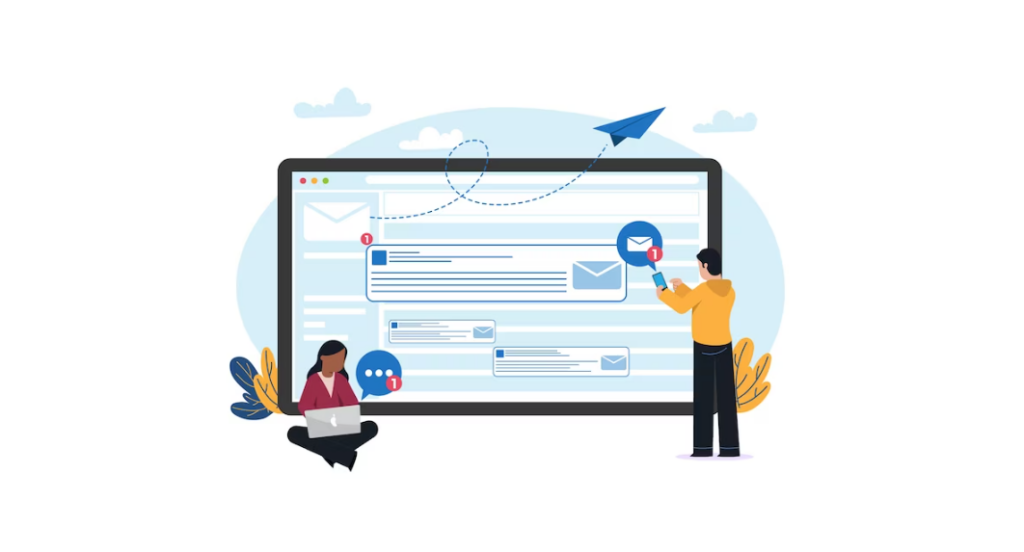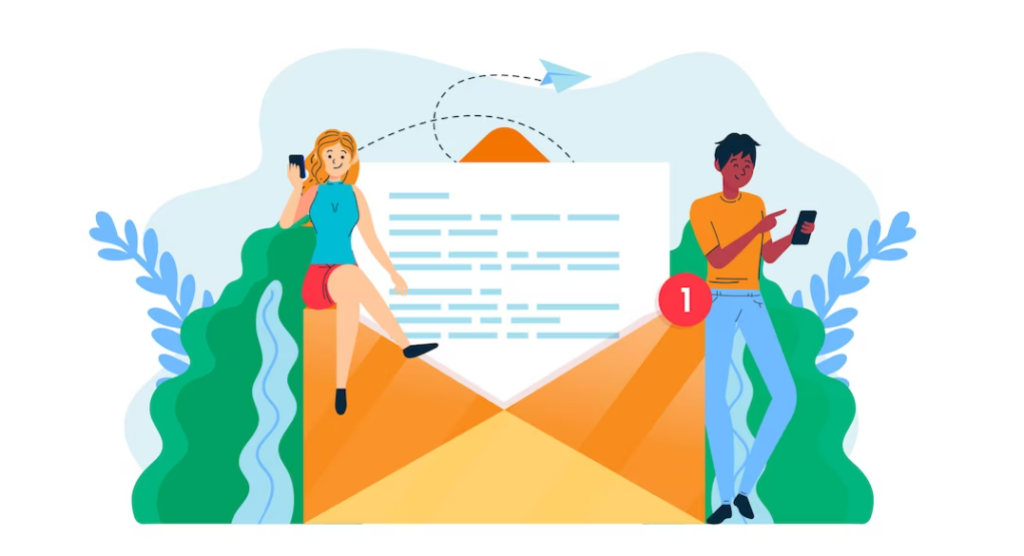
Key Takeaways
- Lead nurturing emails help build lasting connections with potential customers by providing valuable information and guidance.
- The main goal of lead nurturing emails is to establish trust and encourage customers to choose a business's products or services over time.
- Effective lead nurturing emails drive sales, build trust, ensure brand recognition, and guide purchasing decisions.
- Best practices for lead nurturing emails include understanding your audience, segmenting your email list, personalizing content & many more.
- Conducting A/B testing, maintaining consistency, and employing personalization and automation are crucial strategies for successful lead nurturing emails.
- Lead nurturing email examples include welcome emails, educational content emails, abandoned cart reminders & many more.
Lead nurturing emails are like friendly guides in the digital world, helping you build lasting connections with potential customers.
These emails play a crucial role in email marketing lead nurturing, providing valuable information and gentle nudges to guide your leads on their journey to becoming loyal customers.
This article will delve into creating the perfect lead nurturing emails.
We’ll break it down into benefits, practices, strategies and illustrate with practical examples, making it easy for you to craft emails that resonate, engage, and convert leads into devoted supporters.
What is the definition of a lead nurturing email?

A lead nurturing email is like a friendly, helpful message you receive in your email inbox.
It’s sent by a business to people who might be interested in buying their products or services.
These emails are carefully written to provide helpful information and build a connection with you over time.
The main goal of lead nurturing emails is to make you trust the business and, when you’re ready, choose their products or services.
Example: You signed up for a newsletter from a fitness equipment store because you’re interested in working out at home.
After you join, they send you emails with workout tips, product reviews, and special offers on home gym equipment.
These emails are part of their plan for lead nurturing email marketing.
The idea is to gradually give you helpful information and deals so you feel comfortable and informed.
Eventually, you might buy something from them because they’ve been helpful and trustworthy in their emails.
That’s how lead nurturing emails work.
Are lead nurturing emails effective?

Yes, lead nurturing emails are effective. Here are four points discussing the effectiveness of lead nurturing emails:
1. Lead nurturing emails drive sales
When businesses use lead nurturing emails as part of their marketing lead nurturing strategy, they can persuade more people to buy their products or services.
It’s like guiding customers along a path to make a decision.
2. Build trust
These particular emails are like building Trust with a friend.
When a business sends you helpful emails, it’s like saying, “We’re here to help you.”
This trust-building keeps you interested and makes you more likely to choose them when you want to purchase.
3. Remembering the brand through email campaigns
Regular lead nurturing email campaigns ensure you remember a brand.
They stay in your mind like a reminder. When you’re ready to buy, you might think of them first because you’ve seen their emails.
4. Guiding your decisions with email sequences
Lead nurturing emails are like having a helpful guide with you while shopping.
They send you information and offers at just the correct times, helping you decide what to buy.
It’s all part of a well-planned lead nurturing email sequence.
Lead nurturing email best practices

To optimize the impact of your lead nurturing email campaigns, it’s imperative to adhere to these best practices:
1. Understand your audience
Understanding your audience is the foundation of effective email marketing lead nurturing.
It involves researching and collecting data about your subscribers. Know their demographics, interests, pain points, and where they are in their buyer’s journey.
This knowledge helps you create content that speaks directly to their needs and desires.
To gather this information, you can use surveys, analytics tools, and customer interviews.
The more you understand your audience, the more targeted and relevant your lead nurturing emails can be.
2. Segment your audience
Once you deeply understand your audience, segment your email list into distinct groups.
Segmentation allows you to send highly targeted content to specific segments.
For example, you can create segments for new subscribers, loyal customers, or those who have abandoned their shopping carts.
Each segment may have different interests and needs, so tailoring your lead nurturing emails to each group significantly.
It helps to improve engagement and conversion rates in your lead nurturing email campaign.
3. Personalize your emails
The first impression matters in email lead nurturing. Send a warm and personalized email when someone subscribes to your emails.
It helps set a positive tone for your relationship and lets subscribers get to know your brand better.
Include a friendly greeting, introduce your brand’s values, and provide clear expectations about the type and frequency of emails they will receive.
A well-crafted welcome email is the starting point for a successful lead nurturing email sequence.
5. Educate & inform
Lead nurturing emails are an excellent opportunity to position your brand as an industry expert.
Use these emails to share valuable insights, tips, and educational content related to your products or services.
For example, if you sell skincare products, you can send emails about skincare routines, the benefits of different ingredients, and how to address common skin concerns.
By providing genuine value in your lead nurturing emails, you establish trust and authority, making subscribers more receptive to future communications.
6. Clear call-to-action (CTA)
A lead nurturing email without a clear call-to-action (CTA) is like a road without signs.
Each email should have a specific and relevant CTA that guides subscribers on the desired action.
Whether it’s inviting them to read a blog post, watch a tutorial video, request a demo, or make a purchase, the CTA should be prominently displayed and easy to follow.
Use action-oriented language and clarify what benefits the subscriber will gain from that action.
Effective CTAs are pivotal in guiding subscribers through your lead nurturing email campaign.
7. Optimize for mobile
With the prevalence of smartphones, it’s crucial to ensure that your lead nurturing emails are mobile-friendly.
Mobile optimization is essential because many email opens occur on mobile devices.
It includes responsive design, easy-to-tap buttons, and legible text.
Mobile optimization is essential because a significant portion of email opens occurs on mobile devices.
Neglecting mobile-friendliness can lead to a poor user experience and reduced engagement in your email marketing lead nurturing.
8. Monitor engagement metrics
To gauge the effectiveness of your lead nurturing email marketing efforts, closely monitor engagement metrics.
Key metrics include open rates, click-through rates, conversion rates, and unsubscribe rates.
Analyzing these metrics provides insights into how well your emails resonate with your audience.
If you notice declining engagement or high unsubscribe rates, reviewing your email content and strategy is essential.
Monitoring engagement helps you make data-driven adjustments to improve your email lead nurturing.
9. Conduct A/B testing
A fundamental email marketing lead nurturing principle is the willingness to experiment and improve.
Conduct A/B tests on various elements of your emails, such as subject lines, email content, images, and CTAs.
Test different approaches to see what resonates best with your audience.
Continuously refine your email content and strategy based on the results of these tests.
Over time, this iterative process enables you to optimize your lead nurturing email campaigns for better performance.
10. Maintain consistency
Consistency is crucial in lead nurturing email campaigns. Stick to a regular sending schedule so subscribers know when to expect your emails.
Whether you send emails weekly, bi-weekly, or monthly, maintaining a consistent schedule helps build familiarity with your brand.
Consistency also allows you to nurture leads over time, guiding them through their buyer’s journey at their own pace.
It’s like a steady, reliable presence in your subscribers’ inboxes.
11. Personalization & Automation
Personalization and automation are potent tools in email lead nurturing.
Use automation to set up email sequences that deliver relevant content at specific times based on user behavior.
For instance, you can send a welcome series to new subscribers or follow-up emails to those who have abandoned their carts.
Personalize your emails by addressing recipients by name and tailoring content based on their preferences and past interactions.
These personalized, automated emails enhance engagement and make subscribers feel valued in your lead nurturing email marketing.
Use AI tools like LogicBalls Email Writer & Generator to automatically create personalized and behavior-based email sequences that convert.
Lead nurturing email tips

Implement the following potent tips when crafting your lead nurturing emails:
1. Drip email campaigns
Drip email campaigns are a cornerstone of email lead nurturing. These are a series of pre-scheduled emails sent to leads at specific intervals.
Each email in the sequence provides valuable content, and guides leads through their buyer’s journey.
For instance, in an e-commerce lead nurturing email campaign, the first email could introduce the brand, the second email might showcase product categories, and subsequent emails could highlight product features, customer reviews, and special offers.
Drip campaigns keep leads engaged and informed over time.
2. Re-engagement campaigns
Re-engagement campaigns are designed to revive the interest of inactive leads.
If some subscribers last engaged with your emails a while ago, send them a re-engagement email series.
Remind them of the value you offer and provide incentives like discounts or exclusive content to encourage them to re-engage with your brand.
These campaigns help rekindle relationships and bring back leads into your email marketing lead nurturing strategy.
3. Product onboarding emails
Product onboarding emails are vital for software and subscription-based businesses.
When a new customer signs up, a series of onboarding emails can guide them through setting up and using the product effectively.
Provide step-by-step tutorials, tips, and resources to help users get the most out of your product. Effective onboarding fosters a positive first experience and encourages long-term usage.
4. Lead scoring & segmentation
Implement lead scoring to prioritize and segment leads based on their engagement and behavior.
Assign scores to actions like email opens, link clicks, and website visits.
Highly engaged leads can be fast-tracked into more advanced nurturing sequences, while leads showing less interest can receive gentle reminders and educational content.
This segmentation ensures that your lead nurturing emails are precisely targeted.
5. Content relevancy
Ensure that your lead nurturing emails deliver highly relevant content to the recipient. Use data and personalization techniques to tailor the email’s content and recommendations.
For instance, if a lead has shown interest in a particular product category, send them emails related to it.
Personalization enhances engagement and conversion rates in your lead nurturing email marketing.
6. Behavior-based triggers
Utilize behavior-based triggers to send emails at the perfect moment.
For example, if a lead visits a particular product page on your website but doesn’t make a purchase, set up an automated trigger to send a follow-up email with additional information or a limited-time offer related to that product.
Behavior-based triggers make your lead nurturing email sequence responsive and timely.
7. Lead nurture email analytics
Regularly analyze the performance of your lead nurturing email campaigns.
Monitor metrics such as open rates, click-through rates, conversion rates, and unsubscribe rates.
Use this data to assess which emails and strategies work best and where improvements are needed.
Data-driven insights help refine your lead nurturing approach over time.
8. Multi-channel integration
Extend your email marketing lead nurturing efforts beyond email alone. Integrate your email campaigns with other channels like social media and retargeting ads.
For instance, if a lead clicks on a link in one of your emails but doesn’t convert, you can retarget them with relevant ads on social media platforms.
Multi-channel integration amplifies your reach and reinforces your nurturing efforts.
By implementing these lead nurturing email strategies, you can create a dynamic or effective email marketing lead nurturing system that guides leads through their journey, keeps them engaged, and ultimately converts them into loyal customers.
Lead nurturing email examples

1. Welcome email
A welcome email is the opening handshake in your relationship with a lead. This email should make a memorable first impression.
Lead nurturing begins with the initial contact, so crafting a welcome email that is concise, engaging, and relevant is essential.
Here’s an example of a well-crafted lead nurturing welcome email:
Subject line: Welcome to Gezinex!
Hello [First Name],
We’re delighted to have you join the Gezinex community. Your journey with us starts now.
Here are some steps to kickstart your experience:
1. Please explore our website to discover our offerings.
2. Dive into our welcome guide for valuable insights.
3. Take a guided tour of our platform to get acquainted with its features.
If you have any questions, don’t hesitate to reach out. Our team is here to assist you at every step.
Welcome aboard!
Warm regards,
[Your Name]
2. Educational content emails
When it comes to educating your leads, it’s crucial to deliver information that’s valuable and easy to digest.
Educational lead nurturing emails should be informative, engaging, and relevant to the recipient’s interests.
For instance, if you offer financial services, an email might provide tips on intelligent budgeting with clear, actionable steps.
Here’s an example of an effective educational email:
Subject line: Mastering Your Finances
Hello [First Name],
Financial success starts with intelligent money management. At [Your Company], we’re committed to helping you achieve your financial goals.
In this email, we’re sharing our top tips for budgeting like a pro:
1. Create a detailed budget
2. Track your expenses
3. Set savings goals
Remember, we’re here to support you on your financial journey. If you have questions or need personalized advice, please reach out.
Best regards,
[Your Name]
3. Abandoned cart reminders
Abandoned cart emails are a powerful tool to recover potentially lost sales.
They should be persuasive and remind customers of the value they left behind.
Here’s an example of an effective abandoned cart reminder:
Subject line: Don’t Miss Out on Your Favorites
Hello [First Name],
You left something special in your cart at [Your Website]. Your selected items are still waiting for you!
[Product 1]
[Product 2]
[Product 3]
Complete your purchase now and enjoy these fantastic products. Plus, as a thank-you, use code CARTSAVER10 for an extra 10% off your order. Shop Now!
Your cart will only hold onto these items for a while, so act quickly!
Warm regards,
[Your Name]
4. Product recommendations
Personalized product recommendations can significantly enhance your lead nurturing emails.
They should be based on the lead’s previous interactions and preferences.
Here’s an example of an effective product recommendation email:
Subject line: Handpicked Just for You
Hello [First Name],
We thought you might like these based on your recent interactions at [Your Website]:
[Product 1]
[Product 2]
[Product 3]
Explore these curated selections and discover something special. If you have any questions or need assistance, our team is here to help.
Happy shopping!
Regards,
[Your Name]
5. Re-engagement emails
Re-engagement emails aim to win back the attention of inactive leads.
They should acknowledge the recipient’s previous engagement and provide incentives to re-engage.
Here’s an example of an effective re-engagement email:
Subject line: We Miss You!
Hello [First Name],
It’s been a while since we last connected. We value you as part of our community and love to have you back.
Here’s an exclusive 20% discount on your next purchase to sweeten the deal. Use code WELCOME20 at checkout.
Explore our latest offerings. We’ve also been busy enhancing our products and services, so you’ll discover even more value this time.
Welcome back to [Your Company].
We can’t wait to serve you again!
Warm regards,
[Your Name]
Conclusion
In digital communication, lead nurturing emails are your secret weapon.
By following the straightforward tips and real-life examples we’ve shared, you can become a pro at crafting emails that resonate with your audience.
Remember, it’s all about being personal, relevant, and timely. Each email you send is an opportunity to nurture a valuable relationship and guide leads toward becoming your biggest fans.
So, start crafting those engaging emails and watch your lead nurturing efforts bloom. Happy nurturing!
